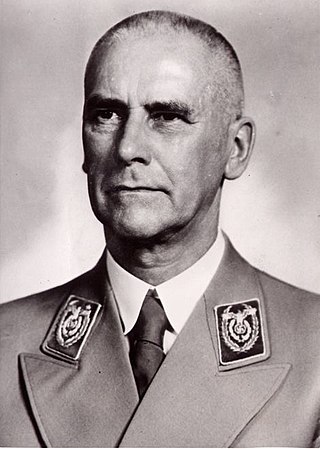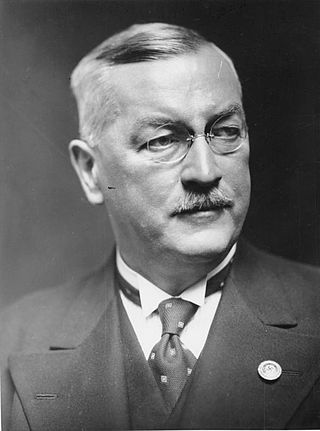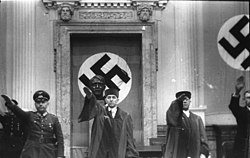The Nazi term Gleichschaltung or "coordination" was the process of Nazification by which Adolf Hitler and the Nazi Party successively established a system of totalitarian control and coordination over all aspects of German society and societies occupied by Nazi Germany "from the economy and trade associations to the media, culture and education". Although the Weimar Constitution remained nominally in effect until Germany's surrender following World War II, near total Nazification had been secured by the 1935 resolutions approved during the Nuremberg Rally, when the symbols of the Nazi Party and the state were fused and German Jews were deprived of their citizenship.

Roland Freisler, was a German jurist, judge and politician who served as the State Secretary of the Reich Ministry of Justice from 1934 to 1942 and as President of the People's Court from 1942 to 1945.

Wilhelm Frick was a prominent German politician of the Nazi Party (NSDAP), who served as Minister of the Interior in Adolf Hitler's cabinet from 1933 to 1943 and as the last governor of the Protectorate of Bohemia and Moravia.

Marinus van der Lubbe was a Dutch communist who was tried, convicted, and executed by the German Nazi regime for allegedly setting fire to the Reichstag building - the national parliament of Germany - on 27 February 1933. During his trial, the prosecution argued that van der Lubbe had acted on behalf of a wider communist conspiracy, while left-wing anti-Nazis argued that the fire was a false flag attack arranged by the Nazis themselves. Most historians agree that van der Lubbe acted alone. Nearly 75 years after the event, the German government granted van der Lubbe a posthumous pardon.

The Reichstag fire was an arson attack on the Reichstag building, home of the German parliament in Berlin, on Monday, 27 February 1933, precisely four weeks after Nazi leader Adolf Hitler was sworn in as Chancellor of Germany. Marinus van der Lubbe, a Dutch council communist, was the apparent culprit; however, Hitler attributed the fire to Communist agitators. He used it as a pretext to claim that Communists were plotting against the German government, and induced President Paul von Hindenburg to issue the Reichstag Fire Decree suspending civil liberties, and pursue a "ruthless confrontation" with the Communists. This made the fire pivotal in the establishment of Nazi Germany.

The Reichstag Fire Decree is the common name of the Decree of the Reich President for the Protection of People and State issued by German President Paul von Hindenburg on the advice of Chancellor Adolf Hitler on 28 February 1933 in immediate response to the Reichstag fire. The decree nullified many of the key civil liberties of German citizens. With Nazis in powerful positions in the German government, the decree was used as the legal basis for the imprisonment of anyone considered to be opponents of the Nazis, and to suppress publications not considered "friendly" to the Nazi cause. The decree is considered by historians as one of the key steps in the establishment of a one-party Nazi state in Germany.

The Enabling Act of 1933, officially titled Gesetz zur Behebung der Not von Volk und Reich, was a law that gave the German Cabinet – most importantly, the Chancellor – the powers to make and enforce laws without the involvement of the Reichstag or Weimar President Paul von Hindenburg, leading to the rise of Nazi Germany. Critically, the Enabling Act allowed the Chancellor to bypass the system of checks and balances in the government.
The judiciary of Germany is the system of courts that interprets and applies the law in Germany.

Josef "Sepp" Dietrich was a German politician and SS commander during the Nazi era. He joined the Nazi Party in 1928 and was elected to the Reichstag of the Weimar Republic in 1930. Prior to 1929, Dietrich was Adolf Hitler's chauffeur and bodyguard.

The People's Court was a Sondergericht of Nazi Germany, set up outside the operations of the constitutional frame of law. Its headquarters were originally located in the former Prussian House of Lords in Berlin, later moved to the former Königliches Wilhelms-Gymnasium at Bellevuestrasse 15 in Potsdamer Platz.

Franz Gürtner was a German Minister of Justice in the governments of Franz von Papen, Kurt von Schleicher and Adolf Hitler. Gürtner was responsible for coordinating jurisprudence in Nazi Germany and provided official sanction and legal grounds for a series of repressive actions under the Nazi regime from 1933 until his death in 1941.

Rudolf Jordan was the Gauleiter in Halle-Merseburg and Magdeburg-Anhalt in the time of the Third Reich. After the war, he was sentenced to 25 years in a Soviet Union labour camp. He was released from the camp in October 1955, and died in Munich in 1988.

Capital punishment in Germany has been abolished for all crimes, and is now explicitly prohibited by constitution. It was abolished in West Germany in 1949, in the Saarland in 1956, and East Germany in 1987. The last person executed in Germany was the East German Werner Teske, who was executed at Leipzig Prison in 1981.

The government of Nazi Germany was a totalitarian dictatorship governed by Adolf Hitler and the Nazi Party according to the Führerprinzip. Nazi Germany was established in January 1933 with the appointment of Adolf Hitler as Chancellor of Germany, followed by suspension of basic rights with the Reichstag Fire Decree and the Enabling Act which gave Hitler's regime the power to pass and enforce laws without the involvement of the Reichstag or German president, and de facto ended with Germany's surrender in World War II on 8 May 1945 and de jure ended with the Berlin Declaration on 5 June 1945.

Curt Ferdinand Rothenberger was a German jurist and leading figure in the Nazi Party.

The People's Courts of Bavaria were Sondergerichte established by Kurt Eisner during the German Revolution in November 1918 and part of the Ordnungszelle that lasted until May 1924 after handing out more than 31,000 sentences. It was composed of two judges and three lay judges. One of its most notable trials was that of the Beer Hall Putsch conspirators, including Adolf Hitler, Erich Ludendorff, Wilhelm Frick, Friedrich Weber, and Ernst Röhm, which lasted from 26 February 1924 until 1 April 1924.

Oswald Rothaug was a Nazi jurist.

The Reichstag, officially the Greater German Reichstag after 1938, was the national parliament of Nazi Germany from 1933 to 1945. Following the Nazi seizure of power and the enactment of the Enabling Act of 1933, it functioned purely as a rubber stamp for the actions of Adolf Hitler's dictatorship — always by unanimous consent — and as a forum to listen to Hitler's speeches. In this purely ceremonial role, the Reichstag convened only 20 times, the last on 26 April 1942. The President of the Reichstag throughout this period was Hermann Göring.

From 1933 to 1945, the Nazi regime ruled Germany and, at times, controlled almost all of Europe. During this time, Nazi Germany shifted from the post-World War I society which characterized the Weimar Republic and introduced an ideology of "biological racism" into the country's legal and justicial systems. The shift from the traditional legal system to the Nazis' ideological mission enabled all of the subsequent acts of the Hitler regime to be performed legally. For this to succeed, the normative judicial system needed to be reworked; judges, lawyers and other civil servants acclimatized themselves to the new Nazi laws and personnel. As of 2021, a few laws from the Nazi era still remain codified in German law.
The Law Against the Formation of Parties, sometimes translated as the Law Against the Founding of New Parties, was a measure enacted by the government of Nazi Germany on 14 July 1933 that established the Nazi Party (NSDAP) as the only legal political party in Germany.



















